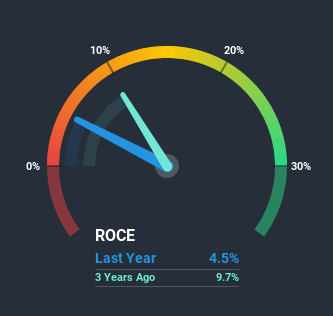Here's What To Make Of Kabra Extrusiontechnik's (NSE:KABRAEXTRU) Returns On Capital

If we want to find a stock that could multiply over the long term, what are the underlying trends we should look for? One common approach is to try and find a company with returns on capital employed (ROCE) that are increasing, in conjunction with a growing amount of capital employed. Ultimately, this demonstrates that it's a business that is reinvesting profits at increasing rates of return. In light of that, when we looked at Kabra Extrusiontechnik (NSE:KABRAEXTRU) and its ROCE trend, we weren't exactly thrilled.
Return On Capital Employed (ROCE): What is it?
For those that aren't sure what ROCE is, it measures the amount of pre-tax profits a company can generate from the capital employed in its business. The formula for this calculation on Kabra Extrusiontechnik is:
Return on Capital Employed = Earnings Before Interest and Tax (EBIT) ÷ (Total Assets - Current Liabilities)
0.045 = ₹113m ÷ (₹3.7b - ₹1.2b) (Based on the trailing twelve months to June 2020).
Therefore, Kabra Extrusiontechnik has an ROCE of 4.5%. Ultimately, that's a low return and it under-performs the Machinery industry average of 9.6%.
See our latest analysis for Kabra Extrusiontechnik

Historical performance is a great place to start when researching a stock so above you can see the gauge for Kabra Extrusiontechnik's ROCE against it's prior returns. If you want to delve into the historical earnings, revenue and cash flow of Kabra Extrusiontechnik, check out these free graphs here.
The Trend Of ROCE
In terms of Kabra Extrusiontechnik's historical ROCE movements, the trend isn't fantastic. Over the last five years, returns on capital have decreased to 4.5% from 15% five years ago. On the other hand, the company has been employing more capital without a corresponding improvement in sales in the last year, which could suggest these investments are longer term plays. It's worth keeping an eye on the company's earnings from here on to see if these investments do end up contributing to the bottom line.
On a side note, Kabra Extrusiontechnik has done well to pay down its current liabilities to 33% of total assets. So we could link some of this to the decrease in ROCE. What's more, this can reduce some aspects of risk to the business because now the company's suppliers or short-term creditors are funding less of its operations. Some would claim this reduces the business' efficiency at generating ROCE since it is now funding more of the operations with its own money.What We Can Learn From Kabra Extrusiontechnik's ROCE
In summary, Kabra Extrusiontechnik is reinvesting funds back into the business for growth but unfortunately it looks like sales haven't increased much just yet. And investors appear hesitant that the trends will pick up because the stock has fallen 22% in the last five years. In any case, the stock doesn't have these traits of a multi-bagger discussed above, so if that's what you're looking for, we think you'd have more luck elsewhere.
If you want to know some of the risks facing Kabra Extrusiontechnik we've found 5 warning signs (1 is concerning!) that you should be aware of before investing here.
While Kabra Extrusiontechnik may not currently earn the highest returns, we've compiled a list of companies that currently earn more than 25% return on equity. Check out this free list here.
If you decide to trade Kabra Extrusiontechnik, use the lowest-cost* platform that is rated #1 Overall by Barron’s, Interactive Brokers. Trade stocks, options, futures, forex, bonds and funds on 135 markets, all from a single integrated account. Promoted
Valuation is complex, but we're here to simplify it.
Discover if Kabra Extrusiontechnik might be undervalued or overvalued with our detailed analysis, featuring fair value estimates, potential risks, dividends, insider trades, and its financial condition.
Access Free AnalysisThis article by Simply Wall St is general in nature. It does not constitute a recommendation to buy or sell any stock, and does not take account of your objectives, or your financial situation. We aim to bring you long-term focused analysis driven by fundamental data. Note that our analysis may not factor in the latest price-sensitive company announcements or qualitative material. Simply Wall St has no position in any stocks mentioned.
*Interactive Brokers Rated Lowest Cost Broker by StockBrokers.com Annual Online Review 2020
Have feedback on this article? Concerned about the content? Get in touch with us directly. Alternatively, email editorial-team@simplywallst.com.
About NSEI:KABRAEXTRU
Kabra Extrusiontechnik
Provides plastic extrusion machinery for manufacturing pipes and films in India.
Solid track record with excellent balance sheet and pays a dividend.
Similar Companies
Market Insights
Community Narratives



